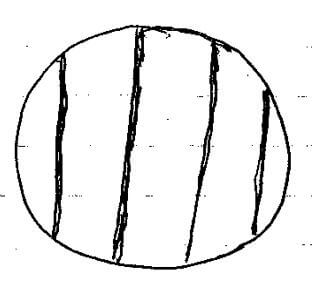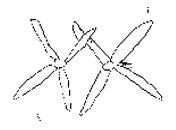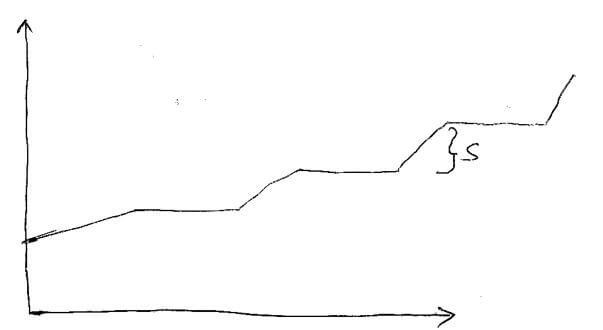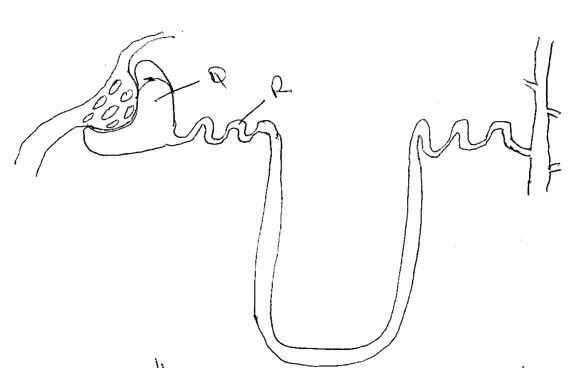Instructions
- Write your name, Index Number and School in the spaces provided above.
- Sign and write the date of the examination in the spaces provided above.
- Answer all the questions in the spaces provided.
- Additional pages must not be inserted.
- Check the question paper to ascertain that all the pages are printed and that no questions are missing.
FOR EXAMINER’S USE ONLY
|
Question |
Maximum Score |
Candidate’s Score |
|
1-25 |
80 |
|
QUESTIONS
-
- State the meaning of the following terms. (1mark)
- Science -
- Biology- (1 mark)
- Explain the following braches of biology. (3 mark)
- Zoology -
- Entomology -
- Morphology –
- State the meaning of the following terms. (1mark)
- The diagram below illustrates a process in an organism of a given species

- Identify the process taking place in the organism above. (1 mark)
- State two economic importance of the organism above. (2 mark)
- HIV/AIDS is a major killer disease with no known treatment. Anti-Retroviral drugs are used to manage it.
- What is the role of anti-Retroviral drugs in HIV/AIDS management. (1 mark)
- Suggest two ways of controlling the spread of HIV/AIDS. (2 marks)
- Name two bones that articulate to form a ball and socket joint at the hip. (2 marks)
- The figures below illustrates specialized cells in an animal’s body.

- Identify the cells M and N. (2 marks)
M –
N – - State the structural differences between M and N. (2 marks)
- Which of the above specialized cells is found in the gut. (1 mark)
- Identify the cells M and N. (2 marks)
- Explain why tracheids are not efficient in transporting water up the plant. (2 marks)
- Insect’s blood is noted to lack a respiratory pigment. Explain. (2 marks)
- Give two destinations of food translocated from the leaves of plants. (2 marks)
- Name the organelle that is likely to be found in abundance in
- An enzyme secreting cell. (1 mark)
- Cell producing lipid related secretions (1 mark)
- A form one student trying to estimate the size of onion cells observed the following on the microscope field of view. (2 marks)

If the student counted 20 cells across the field of view. Calculate the size of one cell in micrometers. (3 marks) -
- Name the cells that secrete mucus in the human alimentary canal (1 mark)
- Explain the role of hydrochloric acid in protein digestion in the stomach of mammals. (2 marks)
- Assume you are a nutritionist, name the kind of vitamins you would recommend to patients with the following conditions
- Poor night vision. (1 mark)
- Bleeding gums (1 mark)
- Excessive bleeding after an injury. (1 mark)
- State the characteristics that distinguish the following organisms into their respective classes,millipedes,spider and Tsetsefly (3 marks)
- Name two classes of phylum Arthropoda with cephalothorax (2 marks)
-
- Name the main group of organisms which comprises the kingdom monera. (1 mark)
- State any three ways in which the organism; named in (a) above affect human lives.(3 marks)
-
- The experiment illustrated below was set up to investigate a certain physiological process using a raw Irish potato tuber.

- Suggest a possible physiological process that was being investigated. (1 mark)
- Explain the results obtained in the above experiment after a few hours. (2 marks)
- State the observations that would have been made if the experiment was repeated using boiled potato. (2marks)
- Explain why growing grass die a few days when salt is sprinkled on it. (3 marks)
- The experiment illustrated below was set up to investigate a certain physiological process using a raw Irish potato tuber.
- Give an example o a sec-linked trait in human one
- Y- chromosome- (1 mark)
- X-Chromosome- (1 mark)
- The diagram below represents a portion of a certain nucleic acid

With reason identify the type of nucleic whose portion is shown above
Identify- (1 mark)
Reason- (1 mark) - The diagram below show a pair of homologous chromosomes. Study them and answer the questions that follow.

- State the genetic significance of the phenomenon. (2 marks)
- The table below shows the percentage composition of carbon (IV) oxide and Oxygen in inhaled and exhaled air. Inhaled air contain oxygen 20% and carbon (IV) oxide 0.04%.
Explain the differences in the percentage of the two gases in inhaled and exhaled airGas
Inhaled air
Exhaled air
Oxygen
20%
17%
Carbon (IV) Oxide
0.04%
40%
- Oxygen. (2 marks)
- Carbon (IV) oxide. (2 marks)
- Give the forms in which the following gases are transported in blood. (3 marks)
- Oxygen
- Carbon (IV) Oxide
- Carbon (II) Oxide
- The following graph represents a growth pattern observed in a group of animals.

- Name the type of growth shown above. (1 mark)
- Name the phylum of animals whose members display the growth pattern named in (a) above. (1 mark)
- Identify the process which lead to increase in body size at part marked S. (1 mark)
- The diagram below show a tip of a plant coleoptile with light coming towards it from one direction.

- How would the plant respond to light. (1 mark)
- Give the name of such a response. (1 mark)
- What is the advantage of plant responding in this way? (2 marks)
- The diagram below illustrates parts of a nephron from a mammalian kidney.

- Name the fluid found in part labelled Q. (1 mark)
- Identify the process that lead to the formation of fluid named in (a) above. (1 mark)
- Which two hormones exert their effect in the nephron? (2 marks)
- Name the habitat of the following plants. (2 marks)
- Xerophytes –
- Halophytes -
MARKING SCHEME
-
-
- Science is the knowledge of natural world based on facts that can be proved by experiment;
- Biology is a branch of science that deals with the study of living things;
-
- Zoology is the study of animals;
- Entomology – is the study of insects;
- Morphology is the study of external structure of organisms; (Rej of plants or of animals)
-
-
-
- Buding;rej asexual reproduction
- Baking bread;
- Brewing of alcohol; (first 2)
- Source of vitamin B;
-
-
- Prolongs the life of the victim by reducing the viral load;
-
- Avoid excessive intake of alcohol
- Avoid indiscriminate sex
- Avoid narcotic drugs
- Avoid wife inheritance
- Avoid female genital mutilation
- Avoid sharing tooth bruises, razers and other implements
- Screen blood before transfusion (1st 2)
- Pelvic giddle;
Femur; -
- M-skeletal/striated muscle;
N – Smooth muscle; - M – has single nucleus while N is multinucleated;
M lacks cross striations while N has cross striations; - M;
- M-skeletal/striated muscle;
- They have perforated cross walls; that hinder continuous flow of water;
- Insects blood is not used for transportation of respiratory gases; as the gasses are transported through tracheal system;
-
- Crowing points;
- Storage sites;
-
- Ribosomes;
- Golgs bodies;
- Lysosomes;
- Diameter of field of view = 4mm-5mm
Number of cells = 20cells
1mm = 100um
mm = (4x1000)um; or (5x1000)um
= 4000um or (5000)um
Size of one cell = 4000/20, 200um; 5000/20 – 250um -
- Goblet ells;
- Activates pepsinogen to pepsin;
Provides an acidic medium for the working of pepsin and rennin/Enzymes in stomach;
-
- Vitamin A/Retinol;
- Vitamin C/Ascorbic acids;
- Vitamin k/quinone;
-
- Number of legs;
- Number of antennae;
- Body segmentation/- Body parts;
- Types of eyes
- Arachnida;
Crustacean; -
- Bacteria;
- Transmit diseases;
- Used in fermentation of milk;
- Add nitrogen to the soil through nitrogen fixation/make soil fertile e.g. rhizobium;
- Help in decay hence circulate nutrients;
(15a tied to b)
-
-
- Osmosis
- Glucose is hypertonic to distilled water; hence water from the trough move to the potato tuber by osmosis
-
- No observable change inside the cylinder;
- Level of distilled water will remain constant;
- Salt exert osmotic pressure on the cells of grass; water is drawn from the cells; by osmosis, the cells loose turgidity/become flaccid; further water loss dehydrates cells; (hence kills the plant) (Max 3mks)
-
-
-
- Hairy pinna;
premature baldness; - Haemophilia,colour blindness
- Hairy pinna;
-
- Identify –Ribonucleic acids; rejRNA
Reason – Presence of organic base uracil; -
- Crossing over
- Allow exchange of genetic; materials leading to variation;
-
- Some of the oxygen diffuse from the alveolus into the blood; where they are transported to the body tissues and used for respiration;
- Some of the carbon (IV) oxide from the body tissues; diffuse from the blood capillaries into the alveoli;
-
- Oxyhaemoglobin;
- (Weak) carbonic acid/carbamino-haemoglobin/hydrocarbonate acc bicarbonate ions
HcO-3 - carboxyhaemoglobin
-
- Intermittent growth curve;
- Arthropoda; (rej if wrong spelling)
- Moulting;
-
- Curves/bend towards the light source;
- Positive phototropism; (rej phototropism alone)
- Enable the plant to obtain light; for photosynthesis;
-
- Glomerular filtrate;
- ultrafiltrations
- Antidiuretic hormone/vasopressin;
Aldosterone hormone;
-
- Desert/semi-desert/Arid areas/Semi-arid areas;
- Salty water/marine;
Download Biology Paper 1 Questions and Answers - Arise and Shine Mock Exams 2022.
Tap Here to Download for 50/-
Get on WhatsApp for 50/-
Why download?
- ✔ To read offline at any time.
- ✔ To Print at your convenience
- ✔ Share Easily with Friends / Students
